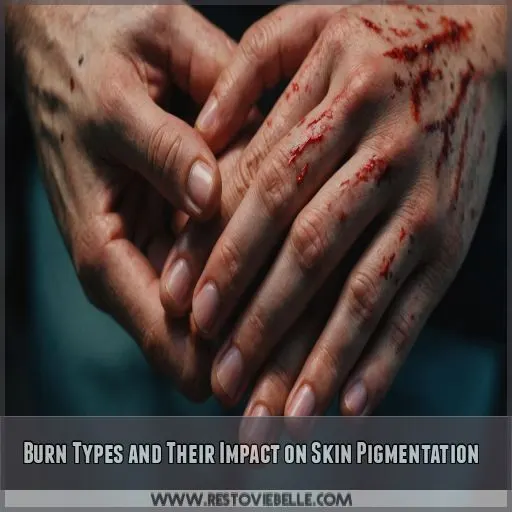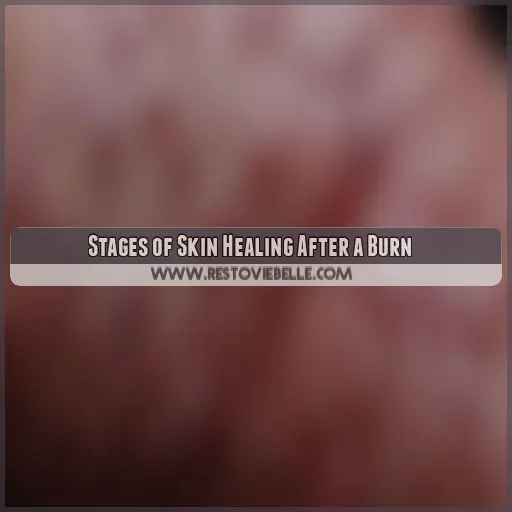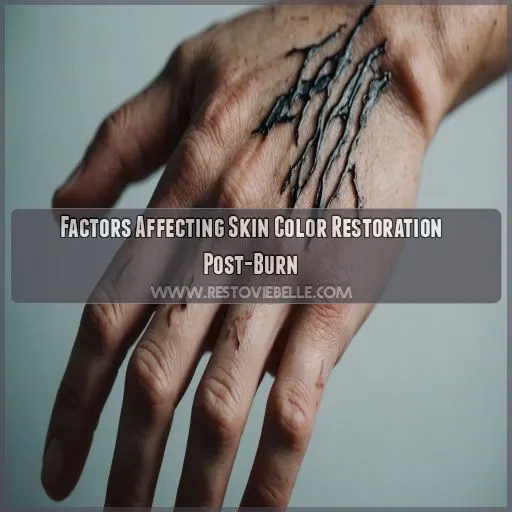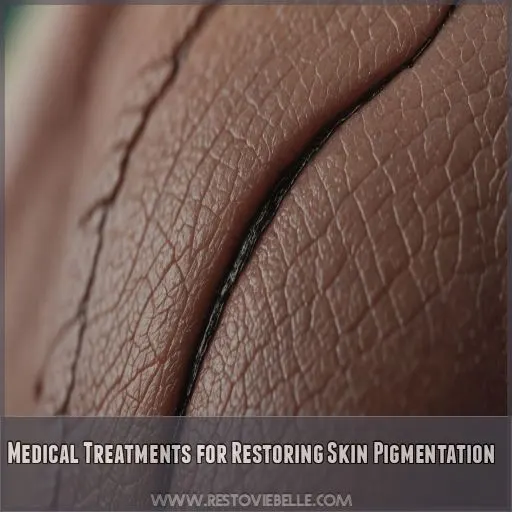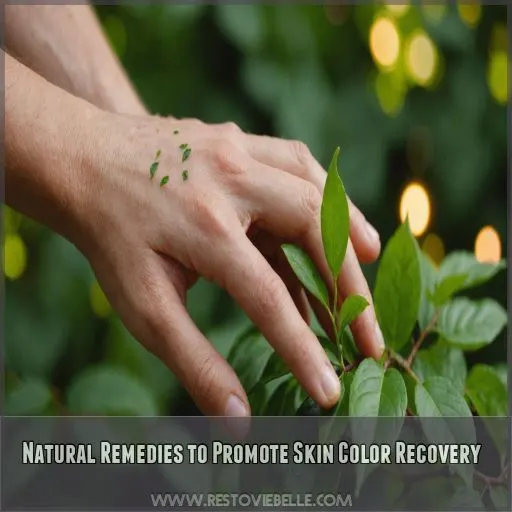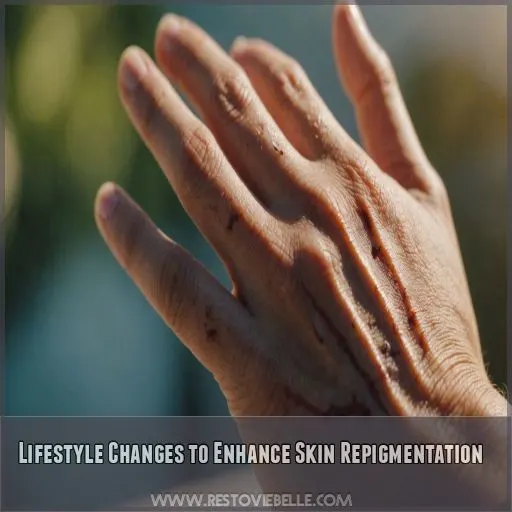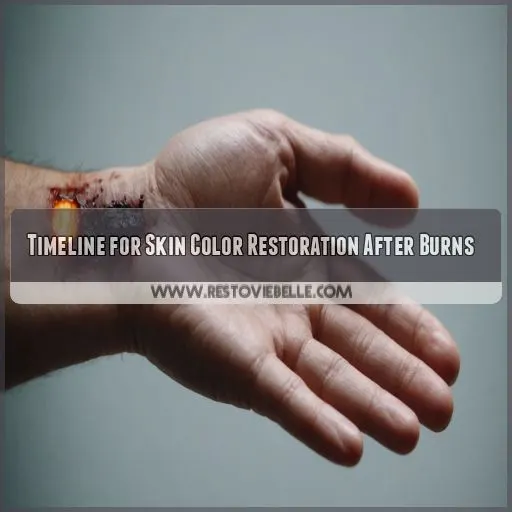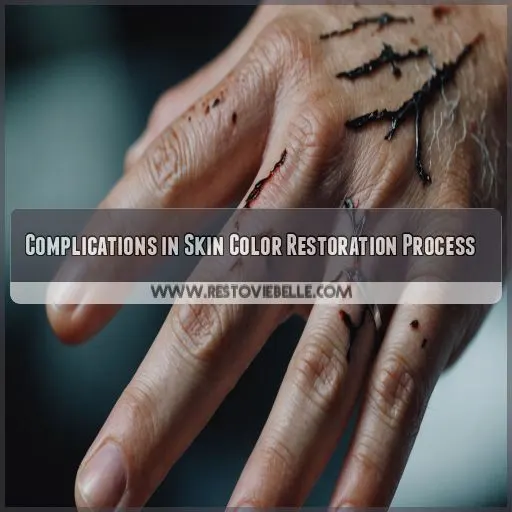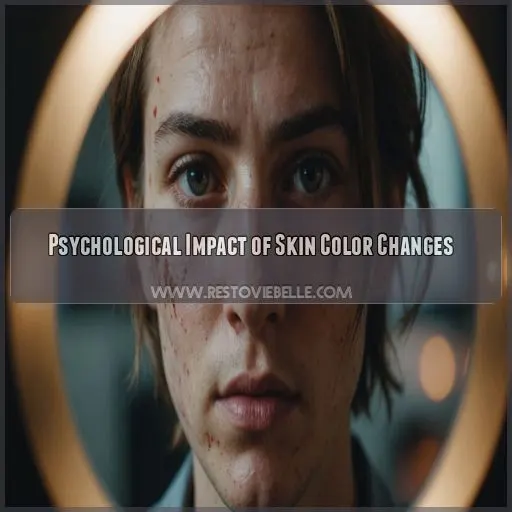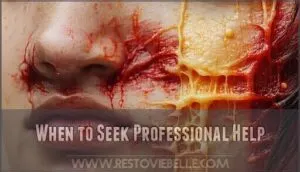This site is supported by our readers. We may earn a commission, at no cost to you, if you purchase through links.
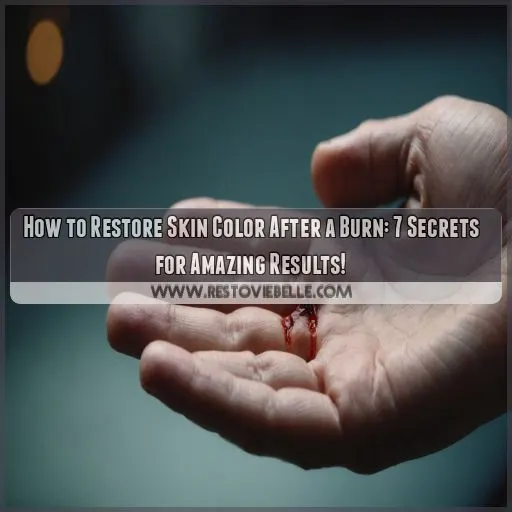
Burns can cause skin to darken or lighten due to inflammation and scarring. The key to restoring skin color is understanding the healing process and using the right treatments.
Topical creams, laser therapy, and Skin grafting can all help. But first, you need to know what type of burn you’re dealing with and how it’s affecting your skin.
Let’s break it down and get your skin back on track!
Table Of Contents
- Key Takeaways
- Burn Types and Their Impact on Skin Pigmentation
- Stages of Skin Healing After a Burn
- Factors Affecting Skin Color Restoration Post-Burn
- Medical Treatments for Restoring Skin Pigmentation
- Natural Remedies to Promote Skin Color Recovery
- Lifestyle Changes to Enhance Skin Repigmentation
- Timeline for Skin Color Restoration After Burns
- Complications in Skin Color Restoration Process
- Psychological Impact of Skin Color Changes
- When to Seek Professional Help
- Frequently Asked Questions (FAQs)
- Will my skin color come back after a burn?
- How to heal discolored skin from a burn?
- How do I get my skin color back after an injury?
- How long does it take for skin to repigment after a burn?
- Can I use makeup to cover burn scars permanently?
- How do burn scars affect my skins sun sensitivity?
- Can burn scars increase my risk of skin cancer?
- Will skin grafting completely restore my original skin color?
- Can I get a tattoo over a fully healed burn scar?
- Conclusion
Key Takeaways
- You’ve got this! Restoring your skin color after a burn is a journey, and it’s essential to understand the healing process. Your skin is like a canvas, and it’s going to take some time to get the color just right. Be patient, and don’t hesitate to reach out for professional help if you need it.
- Don’t try to be a hero – if you’ve got a severe burn, it’s crucial to seek medical attention ASAP. Your doctor can help you navigate the healing process and recommend the best treatments for restoring your skin color. And remember, it’s not just about the physical recovery – your mental health matters too!
- You’re not alone in this journey! Support groups and counseling options can be a huge help in coping with appearance changes. Don’t be afraid to reach out and connect with others who’ve been through similar experiences. And hey, a little humor never hurts – just think of your skin as a phoenix rising from the ashes!
- Time to get your glow back! Restoring skin color after a burn requires a combination of patience, proper care, and the right treatments. Laser therapy, topical creams, and skin grafting can all help stimulate Melanin production and promote healing. Just remember, it’s a marathon, not a sprint – take it one step at a time, and you’ll be rocking your natural glow in no time!
Burn Types and Their Impact on Skin Pigmentation
You’ve suffered a burn, and now you’re wondering how to get your skin color back to normal. Understanding the different types of burns and their impact on skin pigmentation is really important for effective treatment and recovery.
First-Degree Burns and Skin Color Changes
Ever had a sunburn that left you looking like a lobster? That’s a first-degree burn for you! These surface-level burns can mess with your skin color, but don’t panic. Your skin’s got some tricks up its sleeve:
- Redness fades as inflammation subsides
- Peeling reveals fresh skin underneath
- Melanin production kicks in for protection
- Natural healing process restores pigmentation
Second-Degree Burns and Pigmentation Loss
Second-degree burns are no walk in the park.
They dive deeper than first-degree burns, messing with your skin’s pigmentation.
You’ll likely notice blisters and peeling skin, with the damaged area looking red or brown.
Don’t panic! Your body’s natural healing process kicks in, but it might need a helping hand.
Laser therapy and proper home care can be game-changers in restoring your skin color.
Hang in there, champ!
Third-Degree Burns and Permanent Color Alteration
Now, let’s tackle the big kahuna of burns: third-degree. These bad boys don’t mess around, affecting all layers of your skin and causing permanent color changes. Unlike their milder cousins, third-degree burns often require skin grafts or other advanced treatments to restore some semblance of normalcy.
Here’s what you need to know about third-degree burns and color alteration:
- They destroy melanocytes, the cells responsible for skin pigmentation
- Skin grafts may introduce color mismatches
- Laser therapy can help stimulate pigment production
- Micropigmentation offers a cosmetic solution for severe cases
Stages of Skin Healing After a Burn
If you’ve suffered a burn, understanding the stages of skin healing is really important for restoring your natural skin color. Let’s explore the fascinating journey your skin undergoes as it heals, from the initial inflammatory response to the final remodeling phase where pigmentation begins to normalize.
Inflammatory Phase and Initial Color Changes
When you’ve got a burn, your body kicks into high gear. The inflammatory phase is like sending in the cavalry to protect and heal your skin. You’ll notice some changes right off the bat:
| What You’ll See | What’s Happening Inside |
|---|---|
| Redness | Blood vessels dilate |
| Swelling | Fluid rushes to the area |
| Blistering | Skin’s protective response |
| Pain | Nerves signal damage |
| Warmth | Increased blood flow |
Don’t panic! This is your body’s natural response, working overtime to start the healing process.
Proliferation Phase and New Skin Formation
During the proliferation phase, your skin’s like a construction site, bustling with activity to rebuild what’s been damaged. Here’s what’s happening beneath the surface:
- Fibroblasts work overtime, churning out collagen
- New blood vessels form, bringing oxygen and nutrients
- Wound edges slowly creep together, thanks to contraction
- Fresh epidermal cells migrate across the wound bed
- Granulation tissue forms, creating a pinkish, bumpy appearance
It’s a slow process, but your body’s working hard to restore your skin’s structure and function.
Remodeling Phase and Pigment Restoration
As your skin enters the remodeling phase, it’s like a construction site wrapping up its final touches. Your body’s busy laying down collagen and forming scar tissue, while pigment-producing cells start their comeback tour. This stage is super important for restoring your skin’s color, but it’s not a quick fix. Here’s a breakdown of what’s happening:
| Process | What’s Going On | Your Role |
|---|---|---|
| Collagen Production | Skin rebuilding | Stay hydrated |
| Scar Tissue Formation | Wound closing | Gentle massage |
| Melanocyte Return | Pigment restoration | Sun protection |
| Blood Flow Increase | Nutrient delivery | Healthy diet |
| Cell Turnover | New skin revealed | Patience, patience! |
Factors Affecting Skin Color Restoration Post-Burn
Restoring your skin color after a burn isn’t a one-size-fits-all process. Several key factors influence how well your skin recovers its natural pigmentation, and understanding these can help you achieve the best possible results.
Burn Depth and Severity
If you’re trying to get your skin back to its normal color after a burn, the depth and severity of the burn are huge factors.
Think of your skin like a layered cake – the deeper the burn, the longer and harder the healing process.
First-degree burns are like a light sunburn, usually healing without any issues.
But third-degree burns are a whole different story, often needing medical help and potentially leaving permanent changes.
Age and Overall Health
Your age and overall health play a big role in how well your skin bounces back after a burn.
It’s like your body’s own personal repair crew – the younger and healthier you are, the faster they work!
But don’t worry if you’re not in your prime; even older folks can see great results with the right care.
Just remember, a healthy lifestyle is your skin’s best friend!
Skin Type and Ethnicity
Your skin type and ethnicity play a big role in how your skin heals after a burn. Just like we all have unique fingerprints, our skin’s response to injury is one-of-a-kind. Here’s how different skin types react:
- Darker skin tones may be more prone to keloid scarring
- Lighter skin might be at higher risk for hyperpigmentation
- Asian skin often experiences post-inflammatory hyperpigmentation
Aftercare and Treatment Adherence
Sticking to your aftercare plan is like following a recipe for skin success! Your healthcare provider’s instructions aren’t just suggestions—they’re your roadmap to recovery. Here’s a quick guide to keep you on track:
| Do’s | Don’ts |
|---|---|
| Apply cream daily | Skip appointments |
| Keep area clean | Ignore new symptoms |
| Attend check-ups | Forget sun protection |
| Ask questions | Neglect moisturizing |
| Stay patient | Rush the process |
Medical Treatments for Restoring Skin Pigmentation
You’ve probably wondered if there’s a way to restore your skin color after a burn – well, you’re in luck! Modern medicine offers several effective treatments to help bring back your natural pigmentation, from topical creams to cutting-edge laser therapies.
Topical Medications and Their Effectiveness
If you’re trying to get your skin back to its normal color after a burn, topical medications can be your secret weapon.
Hydrocortisone cream might be your new best friend, helping to reduce inflammation and redness.
Retinoids can work wonders for cell turnover, while antibacterial ointments keep nasty infections at bay.
Don’t forget scar creams – they’re like a magic eraser for your skin!
Laser Therapy for Pigment Stimulation
Laser therapy takes pigment restoration to the next level. It’s like giving your skin a wake-up call. Different wavelengths target specific pigments, stimulating melanin production.
You’ll need multiple sessions, but don’t worry, it’s not as scary as it sounds. Just remember to protect your skin from the sun afterward.
Some patients report reduced pain and improved texture. Talk about a win-win!
Skin Grafting Techniques
Moving on from laser therapy, let’s talk about skin grafting techniques. When superficial treatments aren’t enough, your doctor might suggest this surgical option. It’s like giving your burn-damaged skin a fresh start. Grafts come from donor sites on your body or even artificial sources. The healing process can be intense, but the results are often worth it.
- You’ll feel a sense of hope as new, healthy skin takes root
- There’s pride in watching your body heal and transform
- You’ll experience relief as pain and swelling gradually subside
Micropigmentation and Tattooing Options
Ever thought about getting a tattoo to cover up Burn scars? Well, micropigmentation and medical tattooing might be your secret weapons! These techniques can work wonders in restoring skin color after a burn. Let’s break it down:
| Technique | Pros | Cons |
|---|---|---|
| Micropigmentation | Natural look, less invasive | May fade over time |
| Medical Tattooing | Long-lasting results | Requires skilled artist |
| Scar Camouflage | Blends with surrounding skin | Multiple sessions needed |
Natural Remedies to Promote Skin Color Recovery
You don’t need a magic wand to help your skin bounce back after a burn – Mother Nature’s got your back! Let’s explore some natural remedies that can give your skin the TLC it needs to restore its color and confidence.
Aloe Vera and Its Healing Properties
Aloe vera is like a soothing balm for your burned skin, packing a punch with its healing properties.
Its gel composition is a natural burn relief superhero, swooping in with anti-inflammatory effects to calm the angry redness.
Plus, it’s a moisturizing champ, keeping your skin hydrated and happy.
The antioxidant properties in aloe vera fight off pesky free radicals, giving your skin the TLC it needs to bounce back and regain its color.
Vitamin E for Skin Regeneration
Vitamin E is your skin’s superhero sidekick. This powerhouse antioxidant isn’t just for fighting off free radicals.
It’s also a pro at boosting collagen synthesis and wound healing. You can slather it on topically or chow down on some vitamin E-rich foods.
It’s like giving your skin a pep talk, encouraging it to bounce back faster and stronger after a burn.
Coconut Oil as a Moisturizer
Another natural remedy to help restore your skin color is coconut oil. This tropical wonder can work wonders as a moisturizer for burn-healing skin. Here’s how to make the most of it:
- Apply a thin layer twice daily
- Gently massage in circular motions
- Use virgin, unrefined coconut oil for best results
- Store in a cool, dark place to extend shelf life
Honey’s Antibacterial and Healing Effects
Honey is not just for your tea, folks. This sticky superhero packs a punch with its antibacterial properties.
Manuka honey, in particular, is a skin-healing powerhouse. It’ll help keep those pesky infections at bay while soothing inflammation.
Plus, it’s a natural humectant, meaning it’ll keep your skin hydrated. Talk about a bee-autiful solution for your burn recovery!
Lifestyle Changes to Enhance Skin Repigmentation
You’ve got the power to boost your skin’s healing journey after a burn, and it’s all about making smart lifestyle choices. From tweaking your diet to managing stress, these simple changes can work wonders for restoring your skin’s natural color and leaving you feeling confident in your own skin again.
Dietary Adjustments for Optimal Skin Health
You are what you eat, and that’s especially true when healing burn scars.
Boost your body’s repair process with a colorful plate of antioxidant-rich foods. Think of your meals as your skin’s personal construction crew.
Load up on omega-3s to fight inflammation, and don’t skimp on collagen-boosting nutrients like vitamin C.
Your skin will thank you by bouncing back faster and stronger!
Hydration and Its Role in Skin Healing
Hydration is your skin’s best friend when healing from a burn. It’s not just about chugging water, though that’s essential.
Think of your skin as a thirsty plant, needing both internal and external moisture. Slather on hydrating creams to provide external moisture.
Consider running a humidifier to keep your skin’s "soil" moist. This will help maintain a healthy environment for healing.
Don’t forget electrolytes; they’re like plant food for your cells. They play a crucial role in the healing process.
Hydrocolloid dressings can be a game-changer, creating a moisture-rich healing environment.
Sun Protection to Prevent Further Damage
Alright, sun-seekers, listen up! Your healing skin’s like a delicate flower – it needs extra TLC.
Slather on that SPF 50+ sunscreen like it’s going out of style, and don’t skimp on reapplication.
Rock those UV-blocking clothes and accessories – think wide-brimmed hats and sunglasses.
Seek shade like it’s your new best friend.
Stress Management for Better Healing
- Try deep breathing exercises
- Practice mindfulness or meditation daily
- Prioritize good sleep hygiene
- Lean on your social support network
Timeline for Skin Color Restoration After Burns
You’re probably wondering how long it’ll take for your skin to return to its normal color after a burn. Let’s explore the timeline for skin color restoration, from the initial changes in the first few months to the long-term stabilization that can take up to two years.
Short-Term Color Changes (0-3 Months)
In the first three months after a burn, your skin’s going through some major changes. It’s like a rollercoaster ride for your epidermis! You’ll see various stages of healing, each with its own unique color show. Check out this handy table to get a grip on what’s happening:
| Week | Redness | Blistering | Peeling |
|---|---|---|---|
| 1-2 | Intense | Active | Minimal |
| 3-4 | Fading | Healing | Moderate |
| 5-8 | Mild | Resolved | Heavy |
| 9-12 | Minimal | Gone | Tapering |
Medium-Term Pigmentation Process (3-12 Months)
During months 3-12, your skin’s healing kicks into high gear. It’s like your body’s own renovation project.
Melanin production ramps up, and cellular turnover becomes your skin’s best friend.
You’ll notice pigment distribution evening out, but don’t expect miracles overnight.
Keep up with your skin care routine and be patient – your skin’s working hard behind the scenes, even if you can’t always see it.
Long-Term Color Stabilization (1-2 Years)
As you enter the long-term phase, you’ll notice your skin’s color becoming more stable. It’s like watching a garden bloom – slow but rewarding. Here’s what you might experience:
- Subtle shifts in pigmentation, like a chameleon adjusting to its surroundings
- Gradual fading of redness, revealing your true skin tone
- Melanocytes working overtime, like tiny painters restoring your canvas
- Scars softening and flattening, smoothing out your skin’s texture
- Ongoing treatments yielding more noticeable results, like puzzle pieces falling into place
Complications in Skin Color Restoration Process
Restoring your skin color after a burn isn’t always smooth sailing. You might encounter some bumps along the way, from tricky pigmentation issues to pesky infections that can throw a wrench in your healing process.
Hyperpigmentation and Its Causes
As you progress in your healing journey, you might notice some areas of your skin becoming darker than before. This is called hyperpigmentation, and it’s like your skin going a bit overboard with its tan. Let’s break down the main culprits behind this overzealous pigment party:
| Cause | What’s Happening | How It Feels |
|---|---|---|
| Melanin Overdrive | Your skin’s making too much color | Like a patchy suntan |
| UV Exposure | Sun’s stirring up trouble | Frustrating and unfair |
| Hormonal Rollercoaster | Body changes affecting skin | A bit out of control |
Hypopigmentation and Treatment Options
While hyperpigmentation can darken your skin, hypopigmentation does the opposite, leaving light patches that stand out. Don’t worry, though! There are several treatment options to help restore your skin’s natural color:
- Melanocyte stimulation through laser therapy
- Topical medications to encourage pigment production
- Phototherapy techniques to activate melanin-producing cells
- Skin grafting for severe cases
Scarring and Its Effect on Pigmentation
Scarring throws another wrench in the works when it comes to hypopigmentation. Those pesky scars can mess with your skin’s pigment distribution, leaving you with a patchwork of colors.
Melanocyte damage during the burn can lead to permanent pigment loss. This can result in areas of skin that are lighter or darker than the surrounding skin.
Keloid formation might create raised, darker areas. This can be especially frustrating for people who are trying to even out their skin tone.
But don’t worry, there are treatments to help even things out.
Infections and Their Impact on Healing
While scarring can affect pigmentation, infections pose an even bigger threat to your healing journey. They’re like uninvited guests at a party, crashing your skin’s recovery bash. Infections can slow down healing, worsen scarring, and throw a wrench in your skin color restoration plans. Here’s what you need to watch out for:
- Redness that spreads like wildfire
- Fever that hits you out of the blue
- Pus or funky discharge from the burn site
- Increased pain that won’t quit
- Swelling that makes your skin feel like a balloon
Psychological Impact of Skin Color Changes
Dealing with skin color changes after a burn can be emotionally challenging, affecting your self-image and confidence. You’re not alone in this journey, and there are effective ways to cope with the psychological impact while working on restoring your skin’s appearance.
Coping Strategies for Appearance Changes
Dealing with appearance changes after a burn can feel like climbing Mount Everest in flip-flops. But don’t worry, you’ve got this! Let’s explore some strategies to boost your confidence and rock your new look. Remember, beauty isn’t skin deep – it’s about how you shine from within. Check out these nifty tricks to help you strut your stuff:
| Strategy | How It Helps | Try This |
|---|---|---|
| Self-acceptance techniques | Builds inner strength | Daily mirror affirmations |
| Confidence building | Boosts self-esteem | Learn a new skill |
| Adaptive fashion | Enhances comfort & style | Explore makeup or clothing options |
| Positive affirmations | Rewires negative thoughts | "I am strong and beautiful" |
| Social support | Provides encouragement | Join an online community |
Support Groups and Counseling Options
You’re not alone in coping with appearance changes. Support groups and counseling options can be lifelines.
Peer mentoring connects you with others who’ve walked in your shoes, offering a unique understanding and perspective. Online forums provide 24/7 support, allowing you to connect with others at any time.
Group therapy provides a safe space to share feelings and emotions with others who are going through similar experiences. Individual counseling helps you navigate personal challenges and develop coping strategies.
Don’t forget about family support – they’re your built-in cheerleaders, providing love and encouragement throughout your journey.
When to Seek Professional Help
While home care can work wonders for many burns, there are times when you’ll need to call in the pros. Knowing when to seek professional help can make all the difference in your healing journey, so let’s explore some key signs that it’s time to get expert advice.
Signs of Infection or Delayed Healing
For burn healing, you’ve got to keep your eyes peeled for any red flags. Don’t play doctor if you spot these warning signs:
- A funky wound odor that’d make your nose wrinkle
- Fever spikes that have you feeling like a human furnace
- Redness that’s sticking around longer than your ex
- Pus formation that looks like nature’s not-so-fun science experiment
These could mean infection or delayed healing, so it’s time to call in the pros!
Persistent Pain or Discomfort
While signs of infection are red flags, persistent pain or discomfort shouldn’t be ignored either.
If you’re still feeling the burn weeks after the incident, it’s time to call in the pros.
Chronic inflammation or nerve damage might be causing your skin to throw a tantrum. Don’t tough it out – your body’s trying to tell you something.
A doctor can help manage skin sensitivity and prescribe the right meds to get you back on track.
Severe Scarring or Contractures
If your burn scars are pulling your skin tight like a too-small sweater, it’s time to call in the pros.
Contractures can limit your movement and be a real pain in the neck (literally!).
Don’t tough it out – seek help for severe scarring or contractures.
Doctors have tricks up their sleeves, like contracture release, scar massage, and pressure garments, to help you regain freedom of movement and comfort.
Emotional Distress and Mental Health Concerns
While physical recovery is vital, your mental health is just as important. Burns can be traumatic, and it’s normal to feel anxious or depressed about the changes in your appearance. Keep an eye out for these signs that it’s time to seek professional help:
- Withdrawing from loved ones
- Persistent negative thoughts
- Increased substance use
- Trouble sleeping or eating
- Flashbacks or nightmares
Don’t hesitate to reach out for trauma support. It’s all about taking control of your healing journey, inside and out.
Frequently Asked Questions (FAQs)
Will my skin color come back after a burn?
Like a phoenix rising from the ashes, your skin can regain its natural color after a burn, but it’s a gradual process that requires patience and proper care to stimulate melanin production and promote healing.
How to heal discolored skin from a burn?
You can heal discolored skin from a burn by using laser therapy to stimulate melanin production, and applying topical creams that promote skin regeneration. Be patient, as restoring skin color can take time and multiple treatments.
How do I get my skin color back after an injury?
You’re desperate to get your mojo back after an injury left your skin color looking like a patchwork quilt. First off, don’t panic – you’ve got options to get your groove back. Time to kiss that discoloration goodbye!
How long does it take for skin to repigment after a burn?
It varies. Repigmentation can take several weeks to months. It depends on your body’s natural healing process and the severity of your burn. Patience is key to seeing results.
Can I use makeup to cover burn scars permanently?
Think of your skin as a canvas – while makeup can be a great temporary cover-up for burn scars, it’s not a permanent solution. For lasting results, consider professional treatments like laser therapy or microneedling to stimulate collagen and pigment production.
How do burn scars affect my skins sun sensitivity?
After a burn, your skin may be more sensitive to the sun, increasing the risk of further damage and scarring. Be sure to slather on a broad-spectrum sunscreen with at least SPF 30 daily to protect your skin.
Can burn scars increase my risk of skin cancer?
Picture your skin as a shield – burns can leave scars that compromise its strength. Research suggests that burn scars may increase your risk of skin cancer, so it’s really important to monitor and protect your skin.
Will skin grafting completely restore my original skin color?
Skin grafting can improve skin color, but it won’t be a perfect match. The new skin may be a bit lighter or darker, but it’ll be close, like a cousin to your original skin tone.
Can I get a tattoo over a fully healed burn scar?
Ironically, you’re excited about getting inked, but your burn scar is making you hesitant. The good news is, you can get a tattoo over a fully healed burn scar, but consult a doctor and tattoo artist first to discuss potential risks.
Conclusion
You’ve navigated the dark days of burn recovery, and now the light at the end of the tunnel is shining brighter – your skin’s natural glow is returning!
As you’ve learned, restoring skin color after a burn requires patience, the right treatments, and a solid understanding of the healing process.

